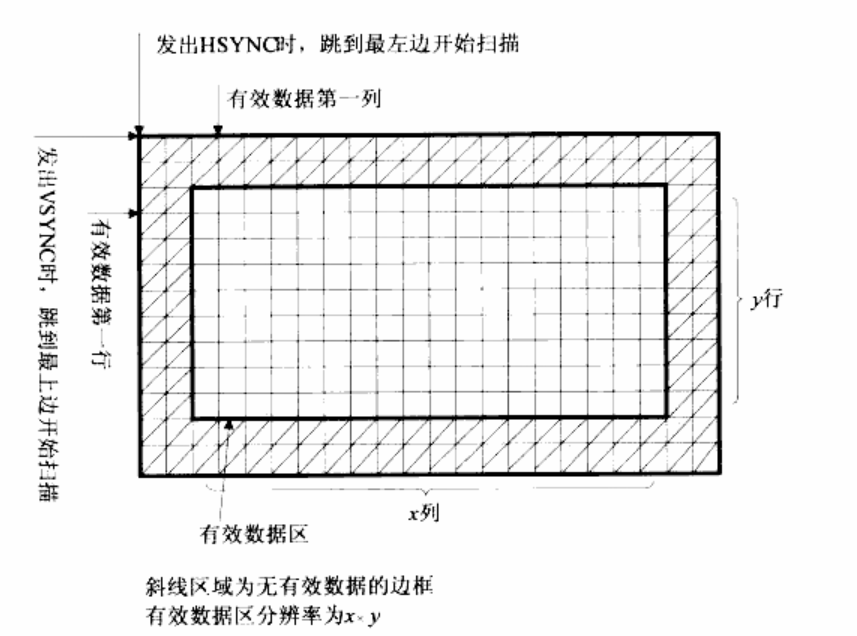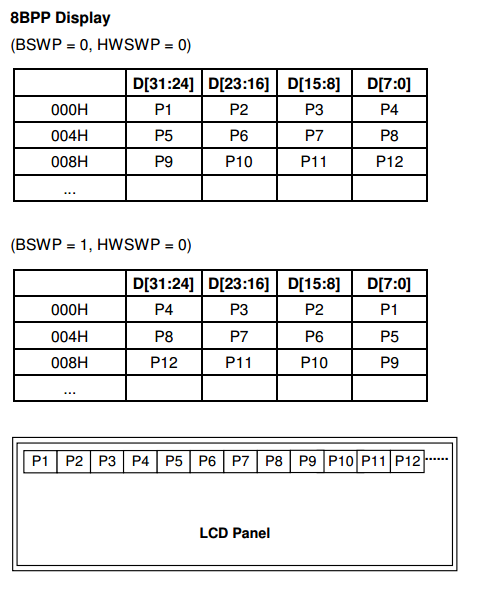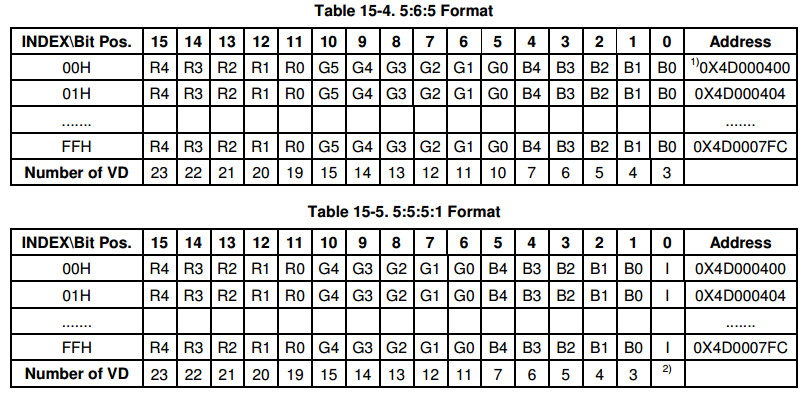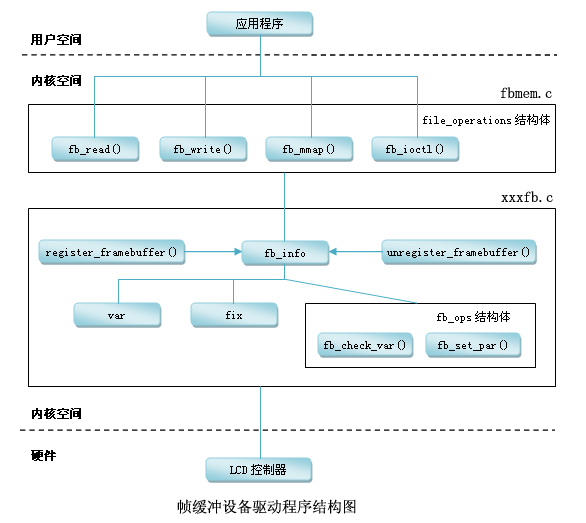LCD驱动程序
学习目标:熟悉TFT LCD的概念,分层驱动工作原理和程序编写。
一、LCD 概念
1. 显示器数据组织格式
1)一幅图像成为一帧,每帧由多行组成,每行由多个像素组成。每个像素的颜色由若干位表示,对于256色LCD,每个像素由8位表示,称为8BPP。
2)显示器呈Z字行的路线进行扫描显示,使用HSYNC、VSYNC控制扫描和跳转的路径;

2、操作过程
1)设置LCD的HSYNC、VSYNC\VCLK等信号的参数,并将帧内存的地址告诉LCD控制器,塔克自动的发起DMA传输,从帧内存中得到图像数据,出现在数据总线VD[23:0]上。我们只需要将显示的图像数据写入帧内存中即可。
2)图像数据的存储:
例如:由三原色组建的256色(8BPP)显示模式,使用8位数据表示一个像素的颜色。但特殊的是,这8位数据用于表示在调色板中的索引值。这里的调色板使用256*16的内存,即使用16BPP的显示格式来表示对应各个索引值的颜色。因此,最终在LCD显示的仍为16BPP的数据。
内存数据和像素对应的关系为:

其中,P1、P2...为一个个的像素。
像素在调色板中的数据存放模式16BPP分为两种格式:5:6:5和5:5:5:1.即:

二、LCD驱动
1、帧缓冲设备
frambuffer设备层是对显示设备的一种抽象。其中,帧缓冲是Linux为显示设备提供的一个接口,它把一些显示设备描述成一个缓冲区,允许应用程序通过FrameBuffer定义好的接口访问这些图形设备,从而不用去关心具体的硬件细节。对于帧缓冲设备而言,只要在显示缓冲区与显示点对应的区域写入颜色值,对应的颜色就会自动的在屏幕上显示。
2、LCD作为一种帧缓冲设备,也是一种标准的字符型设备,对应于文件系统下/dev/fb%d设备文件。
3、驱动结构

首先分析一下driver/video/fbmem.c
1)进入__init fbmem_init(入口函数),主要创建了字符设备“fb”和类,利用cat 命令查看(cat /proc/devices),可看到该目录下的fb,主设备号为29。由于还没有注册LCD驱动,所以没有设备节点,
static int __init fbmem_init(void)
{
create_proc_read_entry("fb", , NULL, fbmem_read_proc, NULL);
//创建字符设备"fb"
if (register_chrdev(FB_MAJOR,"fb",&fb_fops))
printk("unable to get major %d for fb devs\n", FB_MAJOR); fb_class = class_create(THIS_MODULE, "graphics"); //创建类graphics"
if (IS_ERR(fb_class)) {
printk(KERN_WARNING "Unable to create fb class; errno = %ld\n", PTR_ERR(fb_class));
fb_class = NULL;
}
return ;
}
2)fb_fops结构体及open函数
static const struct file_operations fb_fops = {
.owner = THIS_MODULE,
.read = fb_read,
.write = fb_write,
.ioctl = fb_ioctl,
#ifdef CONFIG_COMPAT
.compat_ioctl = fb_compat_ioctl,
#endif
.mmap = fb_mmap,
.open = fb_open,
.release = fb_release,
#ifdef HAVE_ARCH_FB_UNMAPPED_AREA
.get_unmapped_area = get_fb_unmapped_area,
#endif
#ifdef CONFIG_FB_DEFERRED_IO
.fsync = fb_deferred_io_fsync,
#endif
};
-->fb_open函数:
static int fb_open(struct inode *inode, struct file *file)
{
int fbidx = iminor(inode); //取出设备次设备号
struct fb_info *info; //定义一个fb_info结构体
int res = ; if (fbidx >= FB_MAX)
return -ENODEV;
#ifdef CONFIG_KMOD
if (!(info = registered_fb[fbidx])) // 在次设备里面得到fb_info结构信息(lcd的驱动信息)赋值给info
try_to_load(fbidx);
#endif /* CONFIG_KMOD */
if (!(info = registered_fb[fbidx]))
return -ENODEV;
if (!try_module_get(info->fbops->owner))
return -ENODEV;
file->private_data = info;
if (info->fbops->fb_open) { //如果该设备info结构体有open函数,就执行registered_fb[fbidx]->fbops->fb_open
res = info->fbops->fb_open(info,);
if (res)
module_put(info->fbops->owner);
}
return res;
}
由于fb设备(帧缓冲设备)主设备号固定,不同设备以次设备号进行区分,执行该设备open函数时,最终指向的是对应设备的open函数。
接下来看一下fb_read函数:
static ssize_t
fb_read(struct file *file, char __user *buf, size_t count, loff_t *ppos)
{
unsigned long p = *ppos;
struct inode *inode = file->f_path.dentry->d_inode;
int fbidx = iminor(inode); //取出设备次设备号
struct fb_info *info = registered_fb[fbidx]; //定义并获取设备的fb_info结构体
u32 *buffer, *dst;
u32 __iomem *src;
int c, i, cnt = , err = ;
unsigned long total_size; if (!info || ! info->screen_base)
return -ENODEV; if (info->state != FBINFO_STATE_RUNNING)
return -EPERM; if (info->fbops->fb_read)
return info->fbops->fb_read(info, buf, count, ppos); //如果该设备fb_info结构体有read函数,就执行registered_fb[fbidx]->fbops->fb_read total_size = info->screen_size; if (total_size == )
total_size = info->fix.smem_len; if (p >= total_size)
return ; if (count >= total_size)
count = total_size; if (count + p > total_size)
count = total_size - p; buffer = kmalloc((count > PAGE_SIZE) ? PAGE_SIZE : count,
GFP_KERNEL);
if (!buffer)
return -ENOMEM; src = (u32 __iomem *) (info->screen_base + p); if (info->fbops->fb_sync)
info->fbops->fb_sync(info); while (count) {
c = (count > PAGE_SIZE) ? PAGE_SIZE : count;
dst = buffer;
for (i = c >> ; i--; )
*dst++ = fb_readl(src++);
if (c & ) {
u8 *dst8 = (u8 *) dst;
u8 __iomem *src8 = (u8 __iomem *) src; for (i = c & ; i--;)
*dst8++ = fb_readb(src8++); src = (u32 __iomem *) src8;
} if (copy_to_user(buf, buffer, c)) {
err = -EFAULT;
break;
}
*ppos += c;
buf += c;
cnt += c;
count -= c;
}
kfree(buffer);
return (err) ? err : cnt;
}
由以上程序可知,read的调用和open类似。都依赖于对应设备的fb_info结构体info,在程序中是由registered_fb[fbidx]数组获取的。
3)最后,看一下registered_fb[fbidx]数组的定义,位于register_framebuffer函数中。
int register_framebuffer(struct fb_info *fb_info)
{
int i;
struct fb_event event;
struct fb_videomode mode; if (num_registered_fb == FB_MAX)
return -ENXIO;
num_registered_fb++;
for (i = ; i < FB_MAX; i++)
if (!registered_fb[i])
break;
fb_info->node = i; fb_info->dev = device_create(fb_class, fb_info->device,MKDEV(FB_MAJOR, i), "fb%d", i);//创建设备节点,名称为fbi,主设备号为FB_MAJOR 29,次设备号为i
if (IS_ERR(fb_info->dev)) {
/* Not fatal */
printk(KERN_WARNING "Unable to create device for framebuffer %d; errno = %ld\n", i, PTR_ERR(fb_info->dev));
fb_info->dev = NULL;
} else
fb_init_device(fb_info); if (fb_info->pixmap.addr == NULL) {
fb_info->pixmap.addr = kmalloc(FBPIXMAPSIZE, GFP_KERNEL);
if (fb_info->pixmap.addr) {
fb_info->pixmap.size = FBPIXMAPSIZE;
fb_info->pixmap.buf_align = ;
fb_info->pixmap.scan_align = ;
fb_info->pixmap.access_align = ;
fb_info->pixmap.flags = FB_PIXMAP_DEFAULT;
}
}
fb_info->pixmap.offset = ; if (!fb_info->pixmap.blit_x)
fb_info->pixmap.blit_x = ~(u32); if (!fb_info->pixmap.blit_y)
fb_info->pixmap.blit_y = ~(u32); if (!fb_info->modelist.prev || !fb_info->modelist.next)
INIT_LIST_HEAD(&fb_info->modelist); fb_var_to_videomode(&mode, &fb_info->var);
fb_add_videomode(&mode, &fb_info->modelist);
registered_fb[i] = fb_info; //赋值到registered_fb[i]数组中
event.info = fb_info;
fb_notifier_call_chain(FB_EVENT_FB_REGISTERED, &event);
return ;
}
接下来看一下fb硬件驱动程序,以/drivers/video/s3c2410fb.c为例。
1)驱动入口
static struct platform_driver s3c2410fb_driver = {
.probe = s3c2410fb_probe,
.remove = s3c2410fb_remove,
.suspend = s3c2410fb_suspend,
.resume = s3c2410fb_resume,
.driver = {
.name = "s3c2410-lcd",
.owner = THIS_MODULE,
},
};
int __devinit s3c2410fb_init(void)
{
return platform_driver_register(&s3c2410fb_driver);
}
static void __exit s3c2410fb_cleanup(void)
{
platform_driver_unregister(&s3c2410fb_driver);
}
2)当平台设备的驱动和设备匹配后,会直接调用prob函数。
static int __init s3c2410fb_probe(struct platform_device *pdev)
{
struct s3c2410fb_info *info;
struct fb_info *fbinfo;
struct s3c2410fb_hw *mregs;
int ret;
int irq;
int i;
u32 lcdcon1; mach_info = pdev->dev.platform_data; //获取lcd设备信息
if (mach_info == NULL) {
dev_err(&pdev->dev,"no platform data for lcd, cannot attach\n");
return -EINVAL;
}
fbinfo = framebuffer_alloc(sizeof(struct s3c2410fb_info), &pdev->dev); //分配fb_info结构体
if (!fbinfo) {
return -ENOMEM;
}
//设置fb_info结构体
info = fbinfo->par;
info->fb = fbinfo;
info->dev = &pdev->dev; platform_set_drvdata(pdev, fbinfo);
dprintk("devinit\n");
strcpy(fbinfo->fix.id, driver_name);
memcpy(&info->regs, &mach_info->regs, sizeof(info->regs));
/* Stop the video and unset ENVID if set */
info->regs.lcdcon1 &= ~S3C2410_LCDCON1_ENVID;
lcdcon1 = readl(S3C2410_LCDCON1);
writel(lcdcon1 & ~S3C2410_LCDCON1_ENVID, S3C2410_LCDCON1); info->mach_info = pdev->dev.platform_data; fbinfo->fix.type = FB_TYPE_PACKED_PIXELS;
fbinfo->fix.type_aux = ;
fbinfo->fix.xpanstep = ;
fbinfo->fix.ypanstep = ;
fbinfo->fix.ywrapstep = ;
fbinfo->fix.accel = FB_ACCEL_NONE;
fbinfo->fbops = &s3c2410fb_ops;
fbinfo->flags = FBINFO_FLAG_DEFAULT;
fbinfo->pseudo_palette = &info->pseudo_pal; fbinfo->var.upper_margin = S3C2410_LCDCON2_GET_VBPD(mregs->lcdcon2) + ;
fbinfo->var.lower_margin = S3C2410_LCDCON2_GET_VFPD(mregs->lcdcon2) + ;
fbinfo->var.vsync_len = S3C2410_LCDCON2_GET_VSPW(mregs->lcdcon2) + ; fbinfo->var.left_margin = S3C2410_LCDCON3_GET_HFPD(mregs->lcdcon3) + ;
fbinfo->var.right_margin = S3C2410_LCDCON3_GET_HBPD(mregs->lcdcon3) + ;
fbinfo->var.hsync_len = S3C2410_LCDCON4_GET_HSPW(mregs->lcdcon4) + ;
fbinfo->fix.smem_len = mach_info->xres.max *
mach_info->yres.max *
mach_info->bpp.max / ; for (i = ; i < ; i++)
info->palette_buffer[i] = PALETTE_BUFF_CLEAR; if (!request_mem_region((unsigned long)S3C24XX_VA_LCD, SZ_1M, "s3c2410-lcd")) {
ret = -EBUSY;
goto dealloc_fb;
}
dprintk("got LCD region\n");
//硬件相关的操作,中断、时钟....
ret = request_irq(irq, s3c2410fb_irq, IRQF_DISABLED, pdev->name, info);
if (ret) {
dev_err(&pdev->dev, "cannot get irq %d - err %d\n", irq, ret);
ret = -EBUSY;
goto release_mem;
} info->clk = clk_get(NULL, "lcd");
if (!info->clk || IS_ERR(info->clk)) {
printk(KERN_ERR "failed to get lcd clock source\n");
ret = -ENOENT;
goto release_irq;
} clk_enable(info->clk);
dprintk("got and enabled clock\n"); msleep(); /* Initialize video memory */
ret = s3c2410fb_map_video_memory(info);
if (ret) {
printk( KERN_ERR "Failed to allocate video RAM: %d\n", ret);
ret = -ENOMEM;
goto release_clock;
}
ret = register_framebuffer(fbinfo);//注册fb_info结构体
if (ret < ) {
printk(KERN_ERR "Failed to register framebuffer device: %d\n", ret);
goto free_video_memory;
} /* create device files */
device_create_file(&pdev->dev, &dev_attr_debug); printk(KERN_INFO "fb%d: %s frame buffer device\n",
fbinfo->node, fbinfo->fix.id); return ; free_video_memory:
s3c2410fb_unmap_video_memory(info);
release_clock:
clk_disable(info->clk);
clk_put(info->clk);
release_irq:
free_irq(irq,info);
release_mem:
release_mem_region((unsigned long)S3C24XX_VA_LCD, S3C24XX_SZ_LCD);
dealloc_fb:
framebuffer_release(fbinfo);
return ret;
}
小结:
根据驱动结构和程序源码分析可知,lcd驱动程序需要完成以下几部分:
1)分配一个fb_info结构体:由函数framebuffer_alloc() 完成 ;
2)设置fb_info结构体;
3)注册fb_info:register_framebuffer();
4)硬件相关的操作
LCD驱动程序的更多相关文章
- [国嵌攻略][143][LCD驱动程序分析]
LCD驱动程序分析 LCD驱动程序代码在/drivers/video/s3c2410fb.c文件中,在该驱动的s3c2410fb_init中注册了平台驱动,该驱动的初始化代码在s3c24xxfc_pr ...
- LCD驱动程序编写
学习目标:编写LCD驱动程序,熟悉根据芯片手册分析时序图,配置寄存器,并测试LCD程序. 一.LCD驱动程序编写 步骤: 1)分配fb_info结构体 2)设置fb_info结构体 a. 固定参数 b ...
- LCD驱动程序(一)
LCD显示原理: 在JZ2440上,想要让LCD显示,需要几个部分1.LCD硬件 2.开发板上的LCD控制器 3.SDRAM内存存放数据FramBuffer 4.可能还需要一个调色板(实际上是一块内存 ...
- 10. LCD驱动程序 ——框架分析
引言: 由LCD的硬件原理及操作(可参看韦哥博客:第017课 LCD原理详解及裸机程序分析) 我们知道只要LCD控制器的相关寄存器正确配置好,就可以在LCD面板上显示framebuffer中的内容. ...
- 9、LCD驱动程序框架
linux-3.4.2\drivers\video\S3C2410fb.c(内核自带驱动程序) fbmem.c是LCD驱动程序顶层框架文件,是一个通用的文件,在初始化init函数中会注册一个字符设备, ...
- LCD驱动程序架构和分析
一.LCD驱动程序架构 1.裸机驱动代码分析 ①LCD初始化:控制器初始化,端口初始化,指明帧缓冲 ②LCD图形显示:将图形数据写入帧缓冲 void lcd_init() { lcd_port_ini ...
- 11. Linux——LCD驱动程序
由上一节 得出写个LCD驱动入口函数,需要以下4步: 1) 分配一个fb_info结构体: framebuffer_alloc(); 2) 设置fb_info 3) 设置硬件相关的操作 4) 使能LC ...
- LCD驱动程序之层次分析
1.回顾字符设备驱动程序: 字符设备驱动编写的一般步骤: 1)主设备号 2)构造file_operations结构体体 .open = xxxx .read = xxxxx 3)register_ch ...
- 【AT91SAM3S】SAM3S-EK Demo工程中,LCD驱动程序的加载(函数指针结构体)
为了调试LCD,在英倍特的板子上烧Atmel的sam3s-ek_demo_1.4_source示例代码.LCD显示正常了,却找不到LCD的驱动究竟在哪. 花了好久,追踪到了这个执行过程. 进入main ...
随机推荐
- 信用卡精养卡POS机方案
所谓的精养卡,就是模仿有钱人的一种方式,提额难吗!真心不难,难就难在养卡消费 ,信用卡都有,但是不同费率的POS机你有吗,没有POS机难道你真的要去花费去消费吗,你消费的起吗?所以我们这个行业就出现了 ...
- ACM-某大牛的建议
一般要做到50行以内的程序不用调试.100行以内的二分钟内调试成功.acm主要是考算法的,主要时间是花在思考算法上,不是花在写程序与debug上. 下面给个计划你练练: 第一阶段: 练经典 ...
- 高CPU业务
高CPU业务 Gearman是当年LiveJournal用来做图片resize的,大家也明白图片resize是一个高CPU的操作,如果让web网站去做这个高CPU的功能,有可能会拖垮你的 web应用, ...
- 谈谈hashcode和equals的用法
HASH: Hash是散列的意思,就是把任意长度的输入,通过散列算法变换成固定长度的输出,该输出就是散列值.关于散列值,有以下几个关键结论: 1.如果散列表中存在和散列原始输入K相等的记录,那么K必定 ...
- PHP Socket 简单使用
<?php /*socket收发数据 @host(string) socket服务器IP @post(int) 端口 @str(string) 要发送的数据 @back 1|0 socket端是 ...
- spring AOP 代理(静态与动态+使用cglib实现)
一.没有代理模式 缺点: 1.工作量特别大,如果项目中有多个类,多个方法,则要修改多次. 2.违背了设计原则:开闭原则(OCP),对扩展开放,对修改关闭,而为了增加功能把每个方法都修改了,也不便于维护 ...
- java中printf的用法
目前printf支持以下格式: %c 单个字符 %d 十进制整数 %f 十进制浮点数 ...
- POJ 3216 Prime Path(打表+bfs)
Prime Path Time Limit: 1000MS Memory Limit: 65536K Total Submissions: 27132 Accepted: 14861 Desc ...
- 去掉Win7资源管理器左侧不需要的项目
通过修改注册表去掉win7资源管理器左侧你不喜欢的项目: 1,打开注册表WIN+R, 输入:regedit 2,找到HKEY_CLASSES_ROOT \ CLSID \, 再找到对应项, 其包含一个 ...
- 多python版本下,使用pip安装第三方库
说明:win10系统,先安装有Python3.5.2,后又安装了Python2.7.13(并重命名了Python27文件夹下python.exe为python2.7.13.exe),试图使用pip安装 ...
